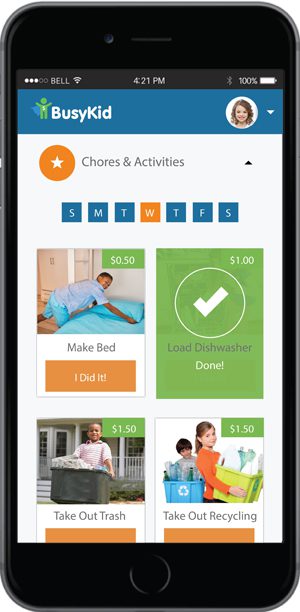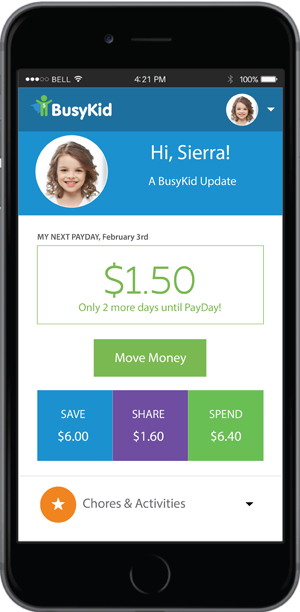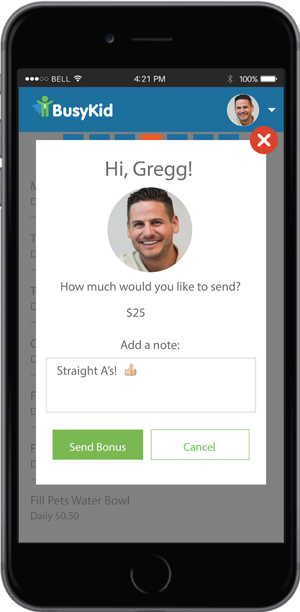

When Gregg Murset looked at the people he works with as a financial planner, two things were consistently present: they work hard and are generally smart with their money.
It was those qualities that Murset wanted to instill in his own six children.
Murset then went to work in creating My Job Chart as a way to help his kids and other parents learn how to manage their chores and receive compensation through an allowance for the jobs they did around the house. His idea of taking the paper chore chart off the fridge and into the digital world, a six-year endeavor, was a success, with almost a million people now using it to help manage family chores.
 Yet there was still something missing from the initial concept, and Murset wanted to refine his approach. That is where he came up with BusyKid, the modern family’s approach to allowance, chore charts, and financial literacy. Murset, the CEO of BusyKid, is now getting the word out about this new tool through the website and family-focused activities that include an RV tour of the United States.
Yet there was still something missing from the initial concept, and Murset wanted to refine his approach. That is where he came up with BusyKid, the modern family’s approach to allowance, chore charts, and financial literacy. Murset, the CEO of BusyKid, is now getting the word out about this new tool through the website and family-focused activities that include an RV tour of the United States.
“With My Job Chart, kids earned points by doing jobs,” says Murset. “Those points then helped them earn money. The system taught them the basic principles. But my objective and vision always was that while points were good, teaching kids how to manage real money was better. They need to get real money in their hands because that’s where kids are really going to learn.”
That’s the genius of BusyKid – its simplicity, its intuitive nature and its investment in how today’s families work. At an annual cost of $14.95 per family, parents and kids get a subscription to the BusyKid service. A debit card also can be attached for another $5 per child annually.
 Here’s how it works: Kids can log on, register their chores and earn money for everything they do around the home or yard. Parents receive texts of what the kids are doing and how much they’ve earned. With a few steps, parents can then transfer money to the kids’ account or onto a pre-paid “Spend Card” for the kids to use.
Here’s how it works: Kids can log on, register their chores and earn money for everything they do around the home or yard. Parents receive texts of what the kids are doing and how much they’ve earned. With a few steps, parents can then transfer money to the kids’ account or onto a pre-paid “Spend Card” for the kids to use.
Kids can move their money online into three separate “buckets” for sharing, spending, and saving. Murset said it makes sense to teach these techniques to younger people, since they are the same techniques that parents and adults use when making decisions about their money,
“It’s really revolutionized the whole allowance thing that so many parents get stuck on,” Murset said. “It’s automated, so it’s simple and easy to use. And while it is controlled by the parents, it empowers a kid to make decisions on their own.”
As a father and professional planner, Murset says he wants nothing more than to see people understand the power of money. For more than 20 years, Murset has led a very successful personal insurance and financial services practice. A graduate of Arizona State University with a degree in finance, he has also earned multiple professional designations in his industry including Certified Financial Planner, ChFC- Chartered Financial Consultant, CLU- Chartered Life Underwriter and REBC- Registered Employee Benefits Consultant.
 Plus, as a dad of six kids, he wants to make sure they get out of his house in a timely fashion, a goal he says (with a laugh) that most parents embrace.
Plus, as a dad of six kids, he wants to make sure they get out of his house in a timely fashion, a goal he says (with a laugh) that most parents embrace.
In doing so, children start to understand the difference between a “need” and a “want.”
They learn financial discipline. They get something at home – financial insights that will last a lifetime – that they may not be getting at school.
And when they have to earn and spend their own money, their financial decisions tend to change.
“It’s a huge teaching opportunity because then when they buy that toy and it’s broken in three days, then you see that they’re learning the importance of quality and buying smart,” Murset said.
Why not give kids paper money and expect them to manage it? Why not teach them the classic envelope system or something like it? Murset says today’s kids just won’t get it. He has added services to BusyKid like being able to buy fractional stock as well to make sure it keeps up with the times – and millennials who want to invest in Google or Amazon.
“It all goes back to the concept of financial abstraction – that’s the concept that money is invisible and it is. So we as parents have a big challenge to teach kids about something that they never see. It’s hard. So that’s what we’re trying to accomplish. We’re giving you tools,” Murset said. “It’s your kid’s first job with direct deposit. Now they’re going to know that’s how it works – you work, the money shows up and you manage it.”






